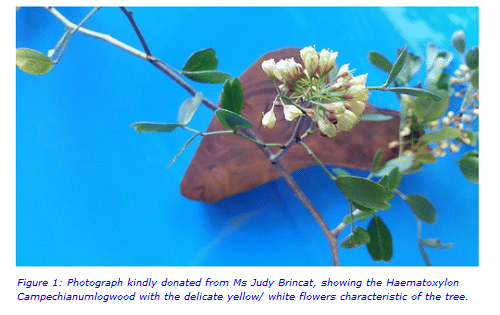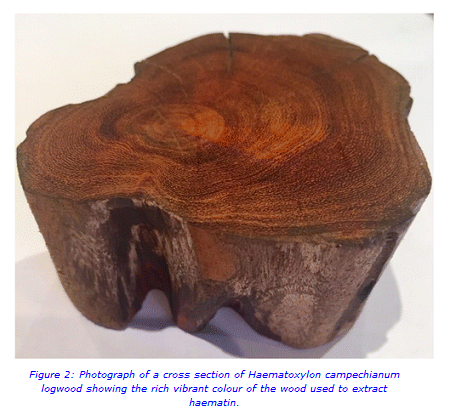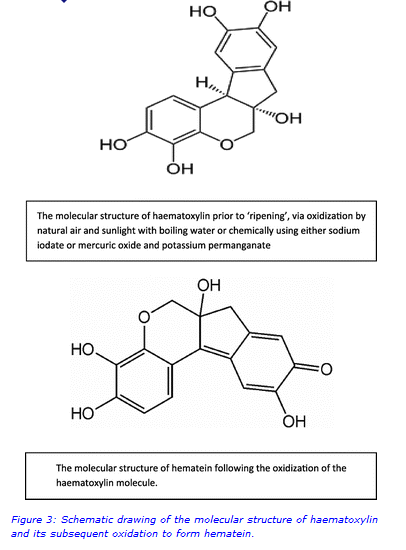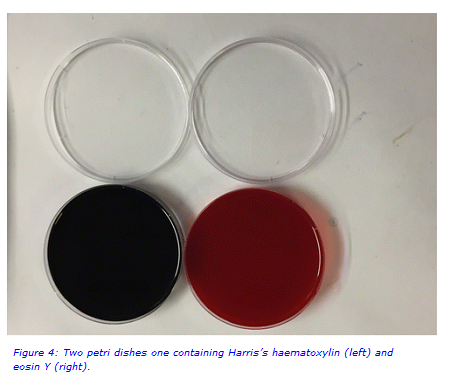Haematoxylin – the story of the blues
The farther back you can look, the farther forward you are likely to see - Winston Churchill
The history of the blues
Haematoxylin is the most well-known dye used in pathology. It remains the primary technique for the demonstration of microscopic nuclear details of cellular and tissue components. However, the story of this remarkable dye dates back hundreds of years, encompassing many different applications and stretching far beyond the histological study of cells and tissues.
Haematoxylin, derived from the Greek words for blood (hematos) and tree (xylos), was originally obtained from the tree Haematoxylon campechianum, found in the Yucatan Peninsula, Mexico(1-3) and documented by Spanish explorers who landed in Campeche in 1517. However, long before this, the Mayan civilisation used extracts from these trees for a multitude of applications, such as a dye to colour cotton-based fabric and a treatment for diarrhoea(1-2).
Since dyed fabrics were novel in Europe, most common clothing in the fifteenth century was rather drab so interest rapidly grew in the use of the logwood extract as a fabric dye. Its trade became largely dominated by the Spanish and was increasingly profitable, making them the envy of European society. At its height, weight for weight, the logwood was more precious than nearly all other merchandise, with an average load being worth more than a year’s cargo of any other commodity(4). As such, the Spanish galleons exporting logwood back to Spain became the focus of pirates and Buccaneer’s alike, including Sir Walter Raleigh, who was known to hide his ship off the Spanish Azores, to then swoop on the Spanish ships and steal the much sort after logwood.


Portuguese explorers were also harvesting another dye wood from Central and Southern America, called brazilin. This red heartwood resembled the glowing embers or coals of a fire and, in Portuguese, the word to describe this is ‘brasa’. Hence from this came the country’s name, Brazil(2).
The Dutch and French also expressed interest in acquiring the Haematoxylin logwood. However, the Spanish claimed a monopoly on all logwood sales and to the profits from established logwood plantations, which led to the seven years’ war between the Spanish, French and English (1756–63). The English, during this time, discovered the Haematoxylin Campechianum trees growing in British Honduras (Belize). Fights over the rights of British to settle and cut these, led to the Treaty of Paris (1763) which gave rights to the British to cut logwood but sovereignty to the Spanish. The British employed woodcutters called ‘Baymen’ and, such was their notoriety, the national flag and currency of Belize depicts the Baymen(4).
Over the centuries, haematoxylin continued to find a use as a fabric dye and was used to stain the uniforms of both the North and South American soldiers during the American Civil War (1861–65). Similarly, it enjoyed another renaissance during both World Wars(1-2), when access to the German manufactured, alternative synthetic dyes, was prohibitive.
During the Elizabethan era, early fabric dyers in England found the colours of haematoxylin to lack permanency. This paved the way for the introduction mordant, which imparted a long-lasting permanency to the dye. Haematoxylin was extracted and oxidised in boiling water to form hematein. Hematein is a complex phenolic compound similar to flavonoid pigments of flowers. There are two basic procedures which convert the haematoxylin to hematein, natural oxidation by exposure to light and air or chemical oxidation employing either sodium iodate or mercuric oxide and potassium permanganate. The chemical method is much faster and results in instantaneous oxidation.
Haematoxylin is a dark blue or violet stain which is basic and positively charged and will bind to substances such as DNA/RNA. The premise of the interaction is that both DNA and RNA in the nucleus and RNA in ribosomes are acidic due to the presence of the phosphate backbones which are integral to the composition of nucleic acids and which are negatively charged. The negatively charged backbones subsequently form salts with basic dyes containing positive charges. Therefore haematoxylin will bind to DNA and RNA and stain them violet.
Hematein is anionic with poor affinity for tissue. It requires the presence of a mordant to impart a positive charge to the complex thus enabling binding to anionic tissue components like nuclear chromatin. The word mordant is derived from the Latin word mordere which is meaning ‘to bite’. Mordants are derived from heavy metals such as aluminium, iron, lead, tungsten and molybdenum(1-2). They are di/tri valent salts or hydroxides of metals which combine as hydroxides with the dye by displacing a hydrogen atom from the dye (Figure 3). The remaining valences of the mordant serve to attach/bind the dye–mordant complex to the tissue components such as phosphate groups to nucleic acids. The result is a more permanent dye colour(5).

The use of the blues in pathology
The application of a mordant to the oxidised haematin dye paved the way for the application of haematoxylin in pathology. It is generally accepted that Waldemeyer introduced the use of haematoxylin in histological examinations in 1862(5). However, debate continues with references to Reichel’s work in 1758(6), using a simple unmordanted solution to study plant material. Bohmer(7) introduced the use of an alum mordant in combination with haematoxylin to obtain selective staining in 1864. Other great landmarks included the introduction of the iron, alum haematoxylin, by Heidenhain in 1892(8) who overcame its instability by adding glacial acetic acid and produced his formula for haematoxylin, still used to this day.
Hematein forms a complex or ‘lake’ with the metal iron molecules but the nature of these complexes is still not fully understood. The word ‘lake’ is derived from ‘Lacca’. Kerria Lacca is an insect found in India and Thailand, which secretes a deposit on trees. This is dissolved in ethanol to make Shellac, popularly used as French polish and in nail varnish (chip free). Over time the term lacca or ‘lac’ has changed to lake and now this is generic term for all dye–mordant complexes(9).
Haematoxylins are classified according to the mordant they contain and there are now many types of haematoxylins available, with differing staining qualities for differing tissue types, nearly all named after those who created them. Examples include aluminium-based mordant haematoxylins such as Ehrlich’s, Mayer’s, Harris’, Gill’s, Delafield’s, Cole’s and Carazzi’s; iron-based mordant haematoxylins such as Weigert’s, Heidenhain’s, Verhoeff’s and Loyez’s; tungsten-based mordant haematoxylins such as phosphotungstic acid haematoxylin (PTAH); molybdenum-based mordant haematoxylins such as Thomas’ and lead-based mordant haematoxylins such as Mallory’s.
Haematoxylin remains the most popular used dye in histology and one of the most influential dyes of all time. However advances in modern day histopathological interpretation have seen the rise of molecular methodology and its influence on the replacement of traditional micro-anatomical histological and cytological studies. Yet it is quite clear that pathological interpretation hinges on the subtleties of the interpretation of the haematoxylin combined with eosin stain (H&E) and H&E staining has remained a gold standard and ‘go to stain’ for pathologists for many years. It has been adapted for use on automated platforms, massively increasing productivity and quality, and, perhaps more importantly, have enabled the standardisation of staining protocols for routine diagnostic use (Figure 4)(11). The role of dye substitutes such as Tango, Newly Blue and Phoenix Blue remains unclear(10) as none have managed to replace haematoxylin despite the shortages of its supply in the twenty-first century.

It is extraordinary that the haematoxylin-eosin stain has stood the test of time as the standard stain for histologic examination. Furthermore this simple and inexpensive dye combination can produce enormous amounts of information about the cells functions or aberrations; yielding many diagnostic clues that might otherwise have been missed12.
For further information, please contact:
Guy Orchard: Consultant Grade Biomedical Scientist/Laboratory Manager, Histopathology Department, Viapath
Email: guy [dot] orchard [at] viapath [dot] co [dot] uk
References
- Ali F, Orchard GE. Hematoxylin in history – the heritage of histology. JAMA Dermatol. 2017;153(3):328. doi:10.1001/jamadermatol.2016.0506
- Titford M. The long history of hematoxylin. Biotech Histochem. 2005; 80(2):73–78.10.1080/10520290500138372
- Cook H. Origins of tinctorial methods in histology. J Clin Pathol. 1997;50(9):716–720.10.1136/jcp.50.9.716
- Armstrong WP. Logwood and brazilwood: trees that spawned two nations. Pacific Horticul. 1992;53:38–43.
- Cooksey C. Hematoxylin and related compounds – an annotated bibliography concerning their origin, properties, chemistry, and certain applications. Biotech Histochem. 2010;85(1):65–82.10.3109/10520290903048418
- Reichel CG. Das vasis plantarum spiralibus. Lipsine: Breitkopf; 1758.
- Allison RT. Haematoxylin – from the wood. J Clin Pathol. 1999;52:527–28.10.1136/jcp.52.7.527
- Heidenhain M. Uher Kern und Protoplasma. Festschrift zur 50 jahr. Doktorjubilaum von Geheimrat AV Koelliker.Leipzig: W Englemann; 1892. p. 109–166.
- Mohanta J, Dey DG, Mohanty N. Studies on lac insect (Kerria lacca) for conservation of biodiversity in Similipal Biosphere Reserve, Odisha, India. J Entomol Zool Stud.2014;2(1):1–5
- Groover A, Geddis C, Finney A. Recent hematoxylin shortage and evaluation of commercially available substitutes. Histologic. 2009;XLII (1):1–4.
- Orchard G, Shams MD, Amico C, et al. New embedding and staining systems prestochill and presto stainer for application in the advancement of Mohs micrographic surgery. Br J Biomed Sci. 2017;4(4):203–208.10.1080/09674845.2017.1348566
- Chan JK. The wonderful colours of the hematoxylin-eosin stain in diafnostic surgical pathology. Int J Surg Pathol.2014;12-32.10.1177/1066896913517939

